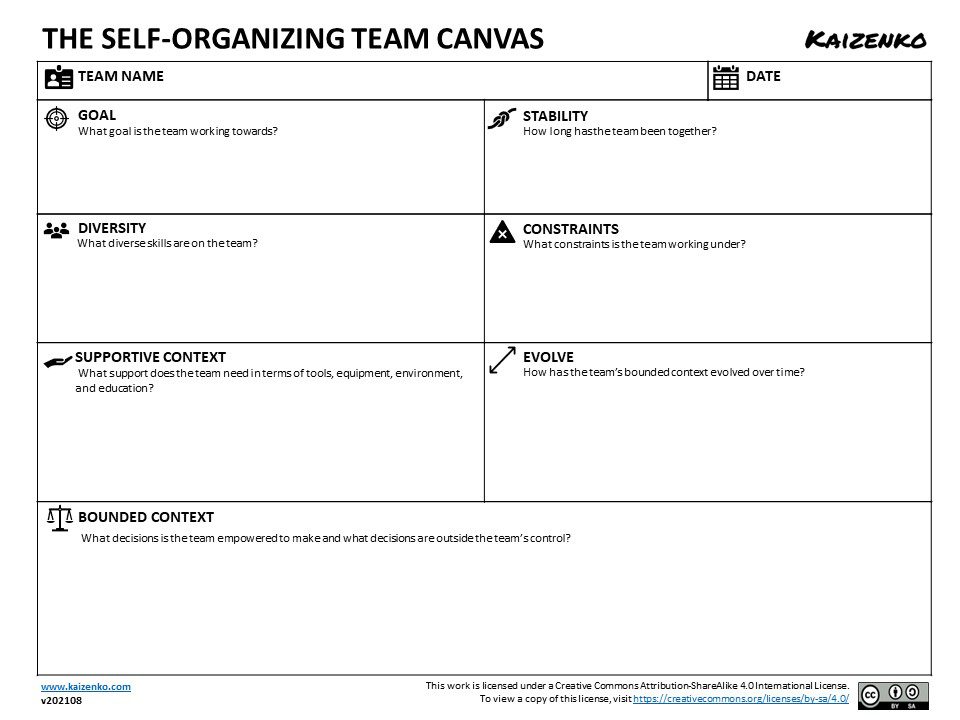Use the Self-Organizing Team Canvas as a template to help you foster a self-organizing team.
Attributes of a self-organizing team include:
- Goal: A team is a group working together collaboratively towards a common goal or vision. Without this common goal or vision, there is little collaboration. It’s just members working in silos and coordinating their activities and sharing status reports. In Scrum, teams work towards a longer term Product Goal and towards shorter term Sprint Goals.
- Constraints: Constraints help the team focus on what’s important and not get distracted by things outside the team’s control. In Scrum, transparency is key and the team’s working conditions and constraints are clearly visible and well understood by all members of the team.
- Diversity: A team working towards a common goal is great, but not enough. In Scrum, teams need to be cross-functional with a diverse set of skills needed to meet the Sprint Goal and product a Product Increment. Use the Cross-Functional Team Canvas to map out all the skills needed to take an idea and convert it into a working product. Identity missing skills and encourage teams to work together to develop their T-shaped skills, and help each other out to deliver, as they are mutually accountable for the delivery of a Product Increment at the end of each Sprint.
- Supportive Context: The team needs support to deliver on their goals. This includes information support in terms of access to people to provide clarification, infrastructure support both in terms of physical space and setup as well as technology and tools, education in terms of training, resources, and upskilling, reward in terms of proper compensation and recognition.
- Bounded Authority: The team needs clear decision making authority. What decisions can the team make on their own, and what decision are not theirs to make? Us the Bounded Context Canvas to clarify the team’s level of authority.
- Stability: The members that form the team join for an extended period of time. They are fully dedicated to the team in order to become a high performing team while they go through Tuckman’s stages of group development – forming, norming, storming and performing. The team transitions from coordinating to cooperating to collaborating to performing. These phases are all necessary and inevitable in order for a team to grow, to face up to challenges, to tackle problems, to find solutions, to plan work, and to deliver results. Every time team composition changes, the team cycles through the development stages again, so stability is essential.
- Evolve: The team needs the space and time to take ownership of how they work and then continuously improve. Bounded authority increases over time while the constraints decrease.
To use the Self-Organizing team canvas, start out by asking the team what goal are they working on. Is the team working towards a goal? Can they agree on just 1 goal? If not, ensure that the team is working towards 1 Sprint Goal at a time moving forward, otherwise this is just a group working in silos and not really a team.
Next, ask the team what constraints are they working under. Make sure these constraints are understood, accepted, and clearly visible. Ask the team to identify which constraints is most problematic or bothersome.
Next, ask the team if they have all the necessary skills to delivery a product increment from Sprint to Sprint? If not, what skills are they missing? Ensure that the team acquires these skills either by adding new members with these skills or training existing members on these skills.
Next, establish the team’s bounded authority. Use the Bounded Context Canvas to list common decision making authority and identify who is authorized to make those decisions.
Next, ask the team how long they have worked together. If the team composition keeps changing, protect the team from future disruptions.
Finally, gradually empower the team to remove a constraint and increase their bounded authority.
Review and update the canvas every 3 months or so. To foster self-organizing teams, try increasing or expanding the team’s bounded authority and reducing the team’s constraints over time.
Click here to download a pdf template of the Self-Organizing Team Canvas.
